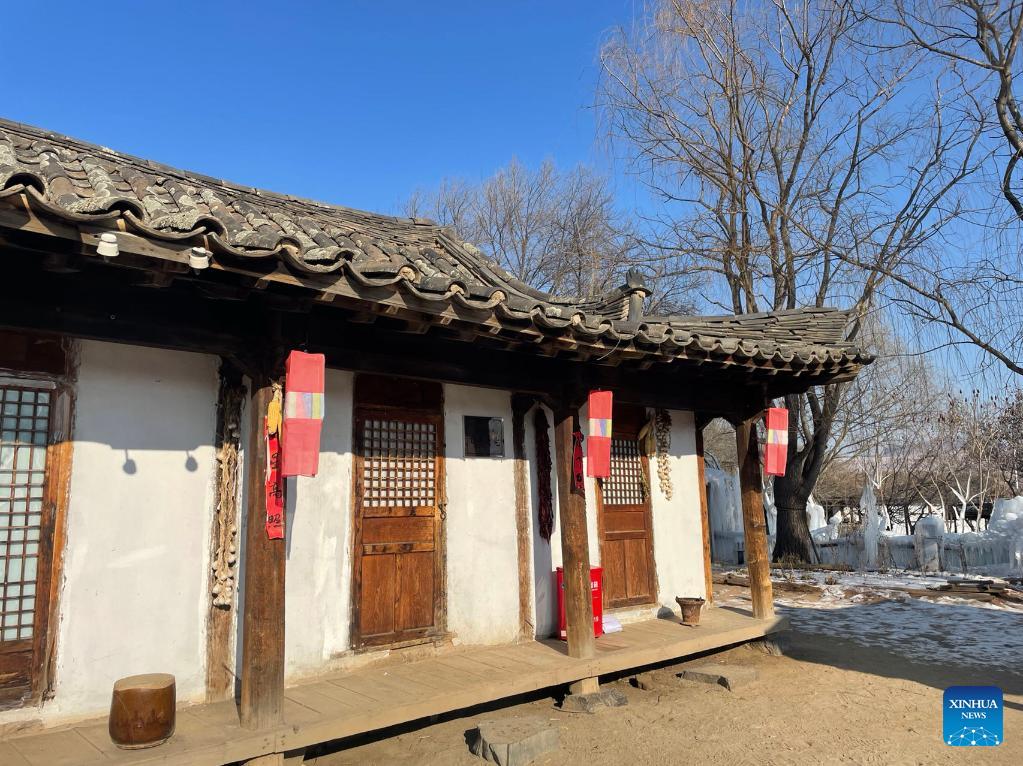
This photo taken on Jan. 9, 2024 shows an ancient house at Bailong Village, Tumen City of northeast China's Jilin Province. (Xinhua/Shao Meiqi)
As night gradually awakens, a rising wave of cooking smoke curls out of a tranquil folk village on the banks of the Tumen River in northeast China's Jilin Province.
In the village, Jin Jingnan is preoccupied with heating up the stove inside a Korean ethnic house over 140 years old. "The tourists will soon arrive," said the 71-year-old.
Much to his delightful surprise, his residence, the oldest one in Bailong Village, is now a popular sight. Facing south, the house was built in 1880 using the traditional mortise-and-tenon joints instead of using nails and screws to join pieces of wood, which experts acclaim as "a rare and well-preserved Korean-style house made with wood and shingles."
The village is situated in Yanbian Korean Autonomous Prefecture, the only autonomous prefecture of China's Korean ethnic group.
Korean-style dwellings dotting the village are connected by wooden bridges and flagstone roads, while crocks used for making and preserving soy sauce are neatly placed between the yards.
Less than 100 people currently reside in the village, mostly over 60 years old, according to Jin. "Few people came to the remote village in the past, but now, their visits allow us to live a much better life," said Jin.
Jin, who used to make a living by working in the Republic of Korea, decided to come back to Bailong Village and settle down in 2005, after seeing how infrastructure and cityscape have undergone tremendous transformation in his hometown. He also began to reconsider the value of the ancient Korean-style houses.
"The history of our village is a microcosm of the history of the Korean ethnic people in China," noted Jin.
Now every day, tourists flood in the village for photo-shooting tours, savoring Korean ethnic cuisine, and experiencing the architecture, customs, and traditional living practices of the Korean ethnic group.
Last year, the village welcomed over 100,000 tourists, according to Jin.
"It's an unforgettable trip," said Zhang Wenli, who came with three friends from Sichuan Province. "We will definitely recommend for more of our friends to visit," Zhang said.
"This year, we plan to open more culinary tours such as making spicy cabbage and rice cakes," Jin said, adding that the village has also set up a team presenting Korean-style performances to sightseers.
"I can make an additional 3,000 to 4,000 yuan (about 422 to 563 U.S. dollars) a month by performing," said Wu Zhenghua, a local resident.
Zhang Xiangshun, 45, opened a beauty salon in Bailong Village last year, mainly offering makeup service to visitors on photo-shooting tours.
After graduation from university, Li Xuanzhu, 24, also moved to the village to run a homestay. "At first, my relatives and friends said that I've made a 'bold' decision, but I was quite optimistic. Now after seeing the influx of visitors, they've recognized my decision," Li said, adding that she is planning to increase investment to inject more vitality into the ancient village. ■